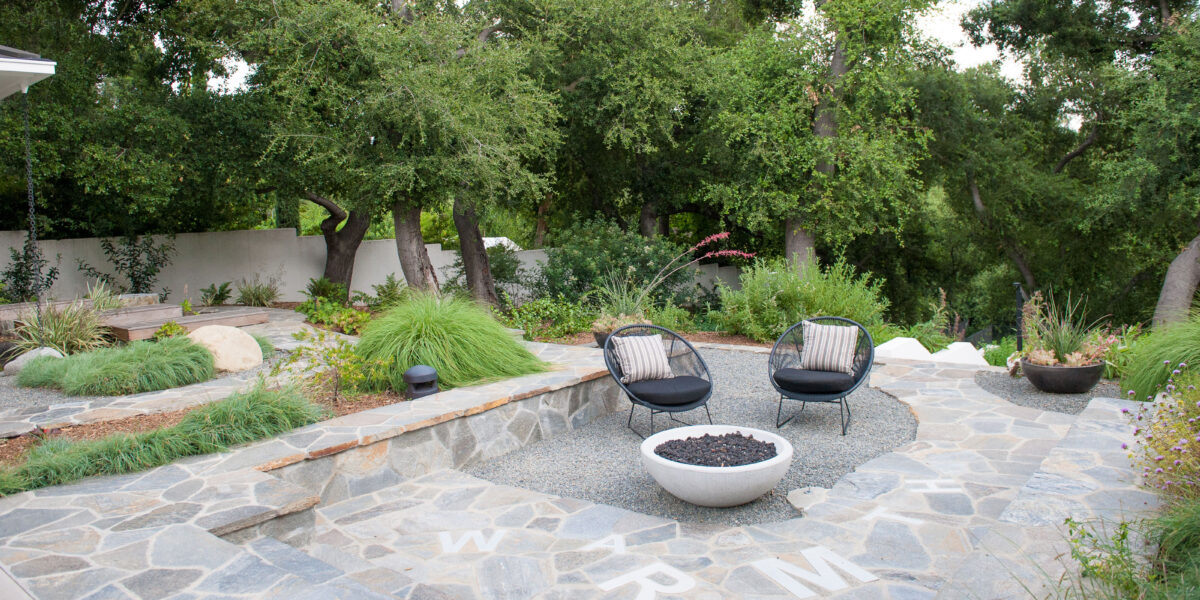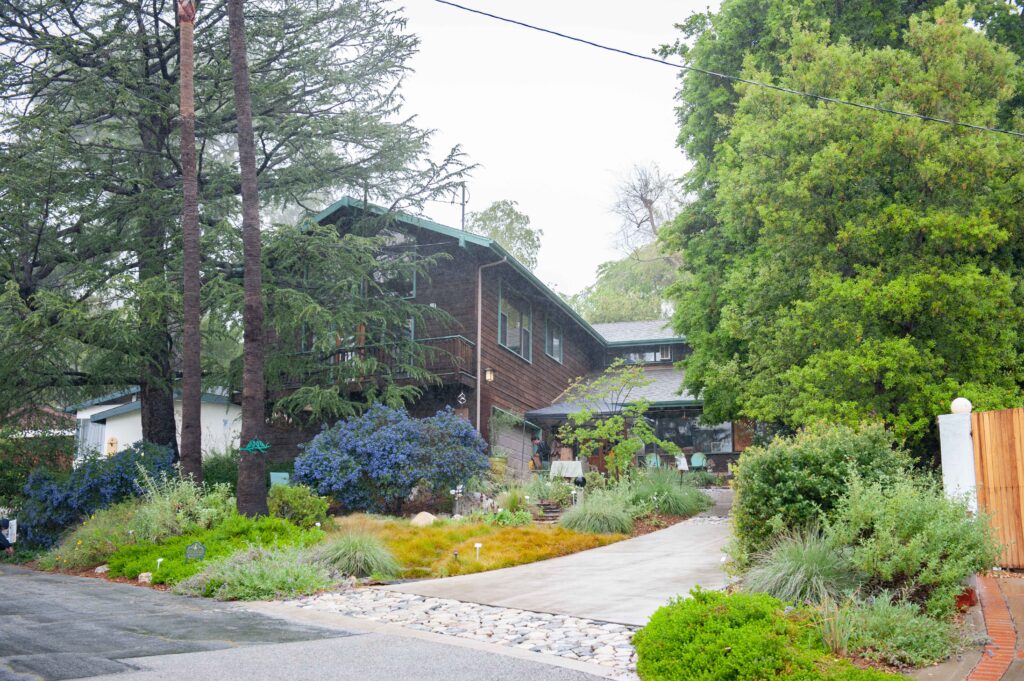
Fire Season Is Now Year-Round. Here’s How to Protect Your Home with a Safer Garden.
Everything you need to know about fire-defensive landscapes.

With recent wildfires flooding the news and ample end-of-summer heat spikes keeping us on our toes, now is as good a time as ever to reconsider fire safety and how that aligns with your garden and landscaping choices. The team behind FormLA designs authentic, beautiful native habitats in Los Angeles, but they also build and maintain “fire-defensive” landscapes which address a home’s distinctive vulnerabilities, and help with strategically choosing, placing, and spacing plants and ember-resistant materials to prevent embers from reaching homes.
Designing for fire defense doesn’t mean you can’t still have an enjoyable entertaining paradise. In fact, their work reflects the best of both worlds with lush, leafy, fragrant, ever-evolving gardens that are full of life. Here, they break down everything from understanding critical areas for clearing to the types of plants they prefer to use for a more fire-safe and resilient landscape.
Know Your Zones

Courtesy of Lesly Hall Photography
When it comes to breaking down the defensible zones within your landscape, FormLA encourages using landscape to provide a final layer of defensive strategy. The most important landscaped space is the five feet closest to the home. It is even more critical where homes are close to one another. To prepare this area for wildfire:
- Place only ember-resistant materials (cement pavers, flagstone, gravel, decomposed granite), at ground level.
- Keep any well-established and healthy tree canopy from the five feet closest to the roof line and 10 feet from chimneys.
- Encourage coordination between neighbors to create mutually defensive ember resistant zones.
Additionally, creating a five-foot, ember-resistant “zone zero” composed of permeable hardscape or concrete provides a walking path that is both attractive and easy to maintain. By using 4-inch black steel edging around zone zero you can create a clean and aesthetically appealing border that can also prevent mulch from spilling into this ember-resistant zone. The combination of organic mulch and native foliage outside of zone zero provides shade, cooling, and hydration, and it inhibits wind-borne embers en route to the home.
5 Things to Remove Now

Courtesy of Lesly Hall Photography
Clutter and extra debris are always a hazard, but you might have other items in your landscape that are increasing your risk during a fire incident:
- Attached Fences and Gates: Once ignited, wood fences and gates build heat great enough to ignite a home.
- Synthetic Turf: Fake grass is a petroleum product that creates heat islands, and will eventually ignite and burn. Once ignited, it releases toxic gases, making a home more difficult to escape and defend.
- “Little Gas Cans” Like Junipers and Cypress: Often planted near homes or as mono-culture privacy screens between properties, the oils in these plants ignite easily and burn hot.
- Fire-Bomb Palms: When palms ignite, they explode, casting embers like sparklers. Their lit fronds can travel 4-5 miles to ignite structures far from a fire front.
- Arson Grasses (Mexican Feather, Fountain, and Pampas Grass): These grasses escape our gardens, traveling to wild spaces unsupported by irrigation where they become easily ignitable fine fuels for fire, as we saw in Hawaii.
- Flammable Mulch: Mulch is marvelous for so many things! However, most mulches can ignite, and some have substantial flame heights. Within five feet of the home, we replace combustible mulch with non-combustible materials (gravel, et cetera). We use compost-grade mulch elsewhere, and never deploy mulch made of petroleum products (e.g. tire mulch, or plastic “fabrics”), even outside of high fire severity zones.
Secure Structures

Courtesy of Lesly Hall Photography
The most easily ignitable, hottest burning, most ember-casting aspects of our properties are man-made. Our homes themselves are the greatest dangers to our neighbors. On petite properties with close neighbors, it is essential to make the structures themselves less receptive to both radiant heat and embers. Do a quick checklist of the following and consider making replacements and/or updates:
- Vents: Replace vent mesh with a fire-resistant mesh.
- Windows: Add double- or triple-pane glass, and install reflective film.
- Roof: Have a Class-A roof, and stay on top of maintenance, repair any damage, and consistently remove litter.
- Eaves and Gutters: Replace wood with fire-resistant material (e.g. Hardie Board) and keep gutters free of litter by covering them with ember-resistant metal mesh.
- Siding: Evaluate siding, and fill any niches or holes where embers could lodge or gain access. Consider more resistant siding materials (e.g. stucco vs. wood), particularly near the foundation.
Plant Considerations

Courtesy of Lesly Hall Photography
Plant Native Foliage: While there is no completely fireproof plant, choosing varieties that maintain health and hydration in high, dry heat and whiplash weather is important. The plants native to a given region will have this advantage and are unlikely to add fire danger to surrounding wildlands in the way that non-native arson grasses have (e.g. fountain grass in Hawaii). In sloped conditions, FormLA also suggests choosing plants with deep roots, as rainfall on burned areas can destabilize soil. For many of their Los Angeles projects they incorporate slope holders like dwarf coyote bush for full sun and snowberry for shadier spots. Planting in clustered drifts with space in between each drift can be beautiful and leave space for vertical specimens, like manzanita or toyon, that break up the clusters.
Place Large Foliage at a Distance: It’s fire-defensive to invert the typical landscape. Rather than placing large shrubs near the home and low growers toward the street, place large ember-catching trees and shrubs at a distance from the house, and lower foliage as you near the home. This makes it easier for you to evacuate and provides more defensible space for firefighters to safely defend your home. This strategy also addresses desires for privacy.
Space Plants for Full Size: When planting foliage, check its maximum full size. Give it space to grow to maturity without interference from other plants or structures. This, as well as clustering, will support foliage health and save you countless hours of maintenance time and will also reduce fire danger.
Preferred Plant List

Courtesy of Lesly Hall Photography
Trees:
Coast Live Oak: If you have space, there is no better ember blocker than this dense, expansive tree canopy. Even when cured as firewood, oak is notoriously slow to ignite and burn.
Toyon: A better fit for small spaces, toyon and Catalina cherry can be limbed-up to form small trees.
Shrubs:
Large: Lemonade berry, Catalina and hollyleaf cherries, California lilac. All have dense, leathery foliage, great for intercepting embers and providing privacy. Clustered, they can form a lovely, biodiverse, ember-blocking hedge.
Mid-Sized: Coffeeberry, (California native) Oregon grape, manzanita. While they have all the qualities of the larger shrubs, these mid-sized shrubs will catch embers bouncing or rolling at a lower trajectory.
Accent: Yucca whipplei: A great fire-resistant, deep-rooting slope retainer.
Groundcovers:
Dwarf coyote bush (one of the best possible deep-rooting slope retainers), manzanita (incredibly fire resistant with hard, dense leaves), Ceanothus, and Oregon grape.
Ongoing Maintenance

Steve Prezant/Getty Images
- Store. Stow all human-made materials (e.g. umbrellas, cushions, some furnishings, toys, tools, exposed propane or gas tanks, garbage cans, hoses, et cetera) in enclosed, ember-resistant areas (inside the home, garage, or designated storage—not under decks) when not in active use.
- Clean. Winds will drive embers to the same places they drive leaves. It’s wise to establish a habit of regularly clearing debris and litter that collects in the five feet nearest the home.
- Inspect and Repair. Shingles, seals, vents, gutters, siding, and fencing can all degrade with time and incur damage as they function. Fixing problems as you see them is easier and safer than taking seasonal or once-a-year action.
- Check Tech: Working irrigation keeps foliage hydrated and healthy, and well directed, functional landscape lighting can help with evacuation and defense. As you inspect and repair problems around the home, keep these on your list.
- Pre-Hydrate. When high heat and winds are forecast, fuel the ability of foliage to resist ignition with deep watering in the days before heat arrives.
FormLA’s Team of Experts:
- Cassy Aoyagi, president, FormLA Landscaping: Cassy has spent decades researching and advocating for fire defensive landscaping strategies.
- Patrick Barrett, enhancements manager, Maintenance Division, FormLA Landscaping: Patrick has worked to prepare many L.A.-area preparation grant recipients for wildfire.
- Clark Stevens, architect, executive officer, Resource Conservation District of the Santa Monica Mountains.
- Pauline Allen, community resilience project manager, RCDSMM.
